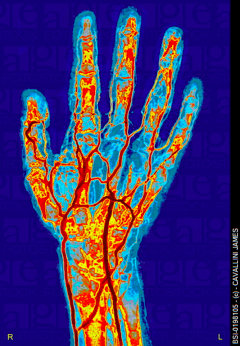Vascular
Vascular Pattern Recognition, also commonly referred to as Vein Pattern Authentication, is a fairly new biometric in terms of installed systems. Using near-infrared light, reflected or transmitted images of blood vessels of a hand or finger are derived and used for personal recognition.
Different vendors use different parts of the hand, palms, or fi ngers, but rely on a similar methodology. Researchers have determined that the vascular pattern of the human body is unique to a specific individual and does not change as people age. Claims for the technology include that it:
ngers, but rely on a similar methodology. Researchers have determined that the vascular pattern of the human body is unique to a specific individual and does not change as people age. Claims for the technology include that it:
Potential for the use of this technology can be traced to a paper1 prepared in 1992 by Dr. K. Shimizu, in which he discussed optical trans-body imaging and potential optical CT scanning applications. In 1996, author Yamamoto, in conjunction with K. Shimizu, presented another paper2 in which the two discussed research they had undertaken since the earlier paper.
The first research paper about the use of vascular patterns for biometric recognition was published in 2000. This paper describes the technology that uses the subcutaneous blood vessel pattern in the back of the hands and that was to become the first commercially available vascular pattern recognition system in 2000.
Additional research has further improved the technology. The introduction of this technology inspired additional research and commercialization into finger- and palm- based vascular systems.
As more recognized biometrics vendors are offering vascular technologies public awareness is increasing. Nevertheless no government has yet adopted the technology for national ID or voter identification.
More at:
A Direction-Based Vascular Pattern Extraction Algorithm for Hand Vascular Pattern Verification
An Biometric Identification System by Extracting Hand Vein Patterns
Comparative Biometric Testing
Explainer: Vascular Pattern Recognition
New Finger Biometric Method Using Near Infrared Imaging
Vascular Pattern Recognition
Footnotes:
Vascular Pattern Recognition, also commonly referred to as Vein Pattern Authentication, is a fairly new biometric in terms of installed systems. Using near-infrared light, reflected or transmitted images of blood vessels of a hand or finger are derived and used for personal recognition.
Different vendors use different parts of the hand, palms, or fi

- is difficult to forge — Vascular patterns are difficult to recreate because they are inside the hand and, for some approaches, blood needs to flow to register an image.
- is contactless — Users do not touch the sensing surface, which addresses hygiene concerns and improves user acceptance.
- has many and varied uses — It is deployed in ATMs, hospitals, and universities in Japan.
- Applications include ID verification, high security physical access control, high security network data access, and POS access control.
- is capable of 1:1 and 1:many matching — Users’vascular patterns are matched against personalized ID cards/smart cards or against a database of many scanned vascular patterns.
Potential for the use of this technology can be traced to a paper1 prepared in 1992 by Dr. K. Shimizu, in which he discussed optical trans-body imaging and potential optical CT scanning applications. In 1996, author Yamamoto, in conjunction with K. Shimizu, presented another paper2 in which the two discussed research they had undertaken since the earlier paper.
The first research paper about the use of vascular patterns for biometric recognition was published in 2000. This paper describes the technology that uses the subcutaneous blood vessel pattern in the back of the hands and that was to become the first commercially available vascular pattern recognition system in 2000.
Additional research has further improved the technology. The introduction of this technology inspired additional research and commercialization into finger- and palm- based vascular systems.
As more recognized biometrics vendors are offering vascular technologies public awareness is increasing. Nevertheless no government has yet adopted the technology for national ID or voter identification.
More at:
A Direction-Based Vascular Pattern Extraction Algorithm for Hand Vascular Pattern Verification
An Biometric Identification System by Extracting Hand Vein Patterns
Comparative Biometric Testing
Explainer: Vascular Pattern Recognition
New Finger Biometric Method Using Near Infrared Imaging
Vascular Pattern Recognition
Footnotes:
- Shimizu, K. Optical Trans-Body Imaging: Feasibility of Optical CT and Functional Imaging of Living Body. Jpn. J. Med. Philos. 1992, 11, 620-629.
- Shimizu, K.; Yamamoto, K. Imaging of physiological functions by laser transillumination. In Advances in Optical Imaging and Photon Migration; Alfano, R.R., Fujimoto, J.G., Eds.; OSA: Orlando, FL, USA, 1996; pp. 348–352.
- An Biometric Identification System by Extracting Hand Vein Patterns